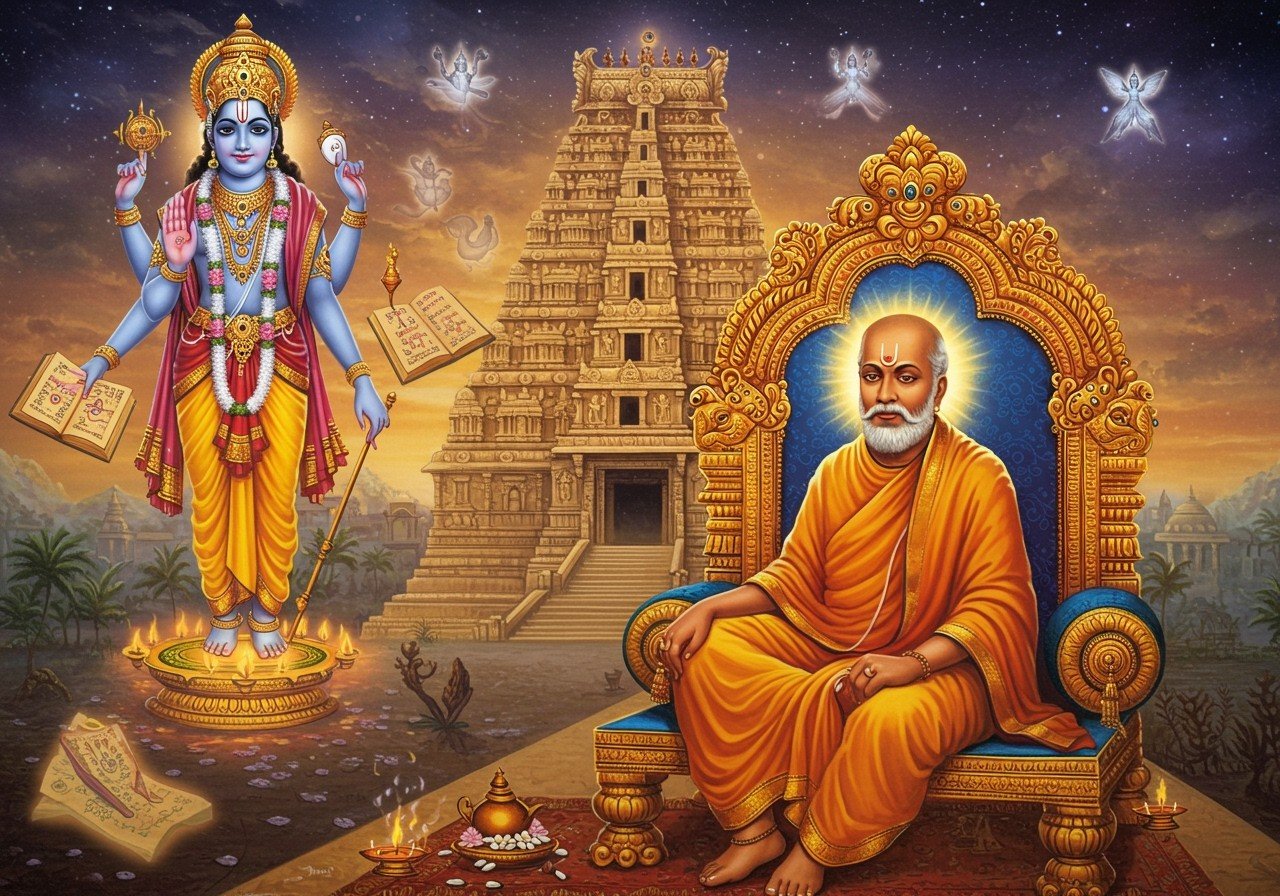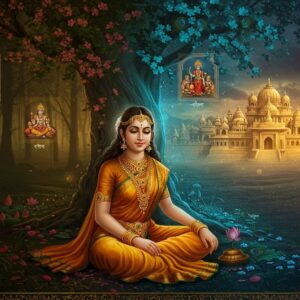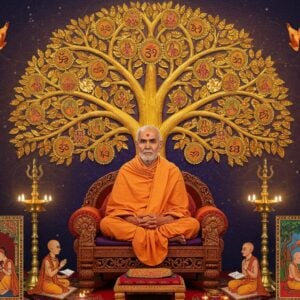
Vishishtadvaita, meaning “non-duality with distinctions,” stands as a cornerstone of Vedanta Hindu philosophy. It presents a unique perspective on non-dualism, acknowledging both the unity with and the distinctiveness from Brahman, the supreme reality. This philosophy beautifully harmonizes the concepts of individuality and unity with the divine.
Core Tenets of Vishishtadvaita
In Vishishtadvaita, Brahman is the ultimate reality, a personal God brimming with attributes and qualities, not merely an abstract concept. The universe and individual souls (jivas) are real and distinct from Brahman, yet eternally connected to and dependent on it. This intricate relationship emphasizes the interconnectedness of all beings with the divine.
Bhakti (devotion) and Prapatti (self-surrender) are essential paths to realize Brahman and attain liberation, or Moksha. Moksha transcends mere freedom from rebirth; it is the profound joy of contemplating God, a state of blissful union.
Key Principles: Tattva, Hita, Purushartha
Vishishtadvaita rests upon three core principles:
- Tattva: This represents the knowledge of the three fundamental entities—jiva (sentient souls), ajiva (non-sentient matter), and Ishvara (Vishnu-Narayana, the Supreme Self). Understanding these entities is crucial to grasping the nature of reality.
- Hita: This outlines the means of realization, primarily through Bhakti (devotion) and Prapatti (self-surrender). These practices pave the way for spiritual growth and understanding.
- Purushartha: This signifies the ultimate goal, Moksha (liberation), which is attained through dedicated practice and divine grace. It is the culmination of spiritual striving.
Ramanuja’s Vision
Ramanuja, the influential 11th-12th century philosopher, championed Vishishtadvaita. He interpreted sacred texts like the Upanishads, Bhagavad Gita, and Brahma Sutras to illuminate the unity in diversity present within creation. His teachings democratized spiritual understanding, opening pathways for all social classes to connect with the divine.
Explore Hindu Philosophy further with our comprehensive guide.
Brahman and Its Qualities
In Vishishtadvaita, Brahman is not an impersonal force but Vishnu or Narayana, a personal God possessing all auspicious qualities. The relationship between Brahman and individual souls is akin to that of the soul and body—interdependent yet distinct. This analogy helps to understand the complex interplay between the divine and the individual.
Liberation (Moksha)
Liberation in Vishishtadvaita transcends the cycle of rebirth. It encompasses the experience of divine joy through devotion and contemplation of God’s perfections. God’s grace plays a vital role in guiding devotees toward this ultimate release. For a deeper understanding of Dharma and Karma, refer to this article.
Contrast with Advaita Vedanta
Unlike Advaita Vedanta, which emphasizes absolute oneness, Vishishtadvaita acknowledges both the unity and distinction between the Creator and creation. While individual souls are dependent on Brahman, they retain their unique identities. This nuanced perspective provides a balanced approach to understanding the nature of reality.
Vishishtadvaita offers a harmonious vision where Brahman, the supreme reality, is a personal God with attributes. The world and individual souls are integral to this reality, eternally connected yet distinct, providing a rich and fulfilling spiritual path. Explore Hinduism’s diverse traditions.
Embracing Vishishtadvaita in Daily Life
Understanding Vishishtadvaita can bring harmony to our spiritual journey. It teaches us that while we are unique individuals, we are also inseparable parts of the divine. By embracing Bhakti and Prapatti, we open ourselves to the grace of Vishnu-Narayana, the path leading to Moksha, where eternal joy and divine contemplation await. Find beautiful idols of Lord Vishnu at Poojn.in.
Ramanuja’s teachings emphasize the inclusivity of spirituality. His vision encourages us to perceive the divine in every facet of life, fostering unity and respect among all beings. As we explore this philosophy, we discover a balanced approach to understanding our place in the universe—connected to Brahman yet distinct.
Practicing Vishishtadvaita involves honoring tradition while finding modern ways to deepen our spiritual connection. We can blend faith and devotion with the ease of today’s world through rituals, prayer, or meditation. Enhance your Puja with authentic samagri from Poojn.in. Vishishtadvaita offers a fulfilling path that enriches our lives and draws us closer to the divine.
FAQs on Key Figures and Texts of Vishishtadvaita: A Clear Explanation
Who is considered the main proponent of Vishishtadvaita? Ramanuja, a revered philosopher and theologian who lived in the 11th-12th century, is considered the main proponent of Vishishtadvaita.
What are the central texts of Vishishtadvaita? The central texts include the Sri Bhashya, a commentary on the Brahma Sutras; the Gita Bhashya, a commentary on the Bhagavad Gita; and the Vedartha Sangraha, which outlines Ramanuja’s interpretation of Upanishadic teachings. These texts provide profound insights into the philosophy.
What is the core principle of Vishishtadvaita Siddhanta? The Vishishtadvaita Siddhanta emphasizes the unity of the soul with the Supreme Being (Brahman) while acknowledging the individual identity of the soul and the reality of the material world.
How does Vishishtadvaita distinguish itself from Advaita Vedanta? Vishishtadvaita differs from Advaita Vedanta by recognizing the individuality of souls and the reality of the material world, contrasting with Advaita’s concept of absolute non-duality.
Who were other significant figures in Vishishtadvaita apart from Ramanuja? Other key figures include Yamunacharya, who laid the groundwork for the philosophy, and Vedanta Desika, known for his brilliant expositions of Ramanuja’s teachings.
Why is Ramanuja’s contribution so important to Vishishtadvaita? Ramanuja’s contribution is crucial because he systematized Vishishtadvaita, harmonizing devotion and philosophy, and making it accessible to a wider audience.
Which texts are recommended for a deeper understanding of Vishishtadvaita? For a deeper understanding, explore the Sri Bhashya, Gita Bhashya, Vedartha Sangraha, and the Upanishads with Ramanuja’s commentaries. These texts provide a comprehensive overview of the philosophy.
How does Vishishtadvaita perceive the relationship between the individual soul and the Supreme Being? Vishishtadvaita views the soul as an integral part of the Supreme Being, possessing a distinct identity yet inseparably connected in essence and purpose.
Learn more about Hindu symbols and their importance in this blog post


